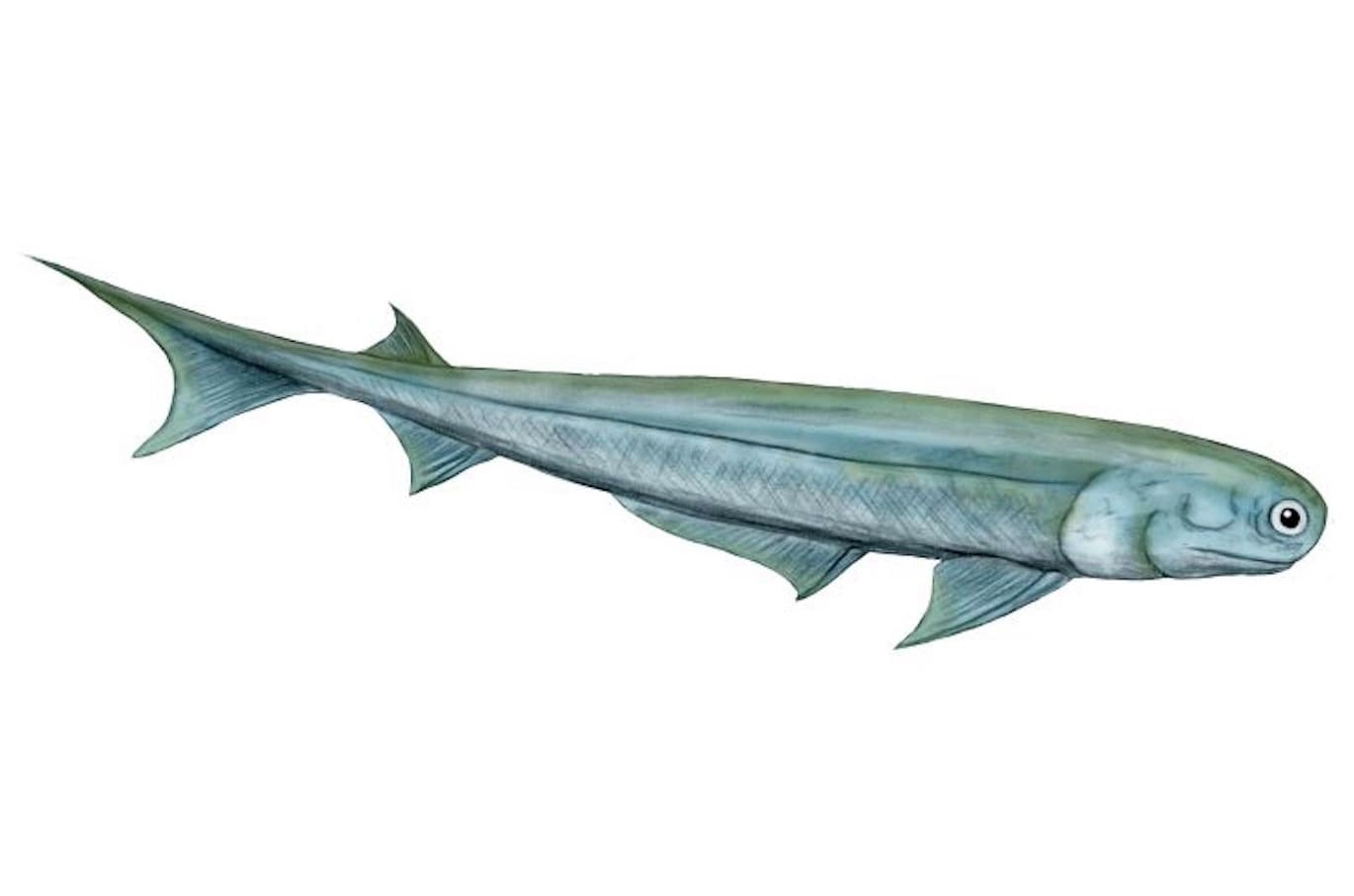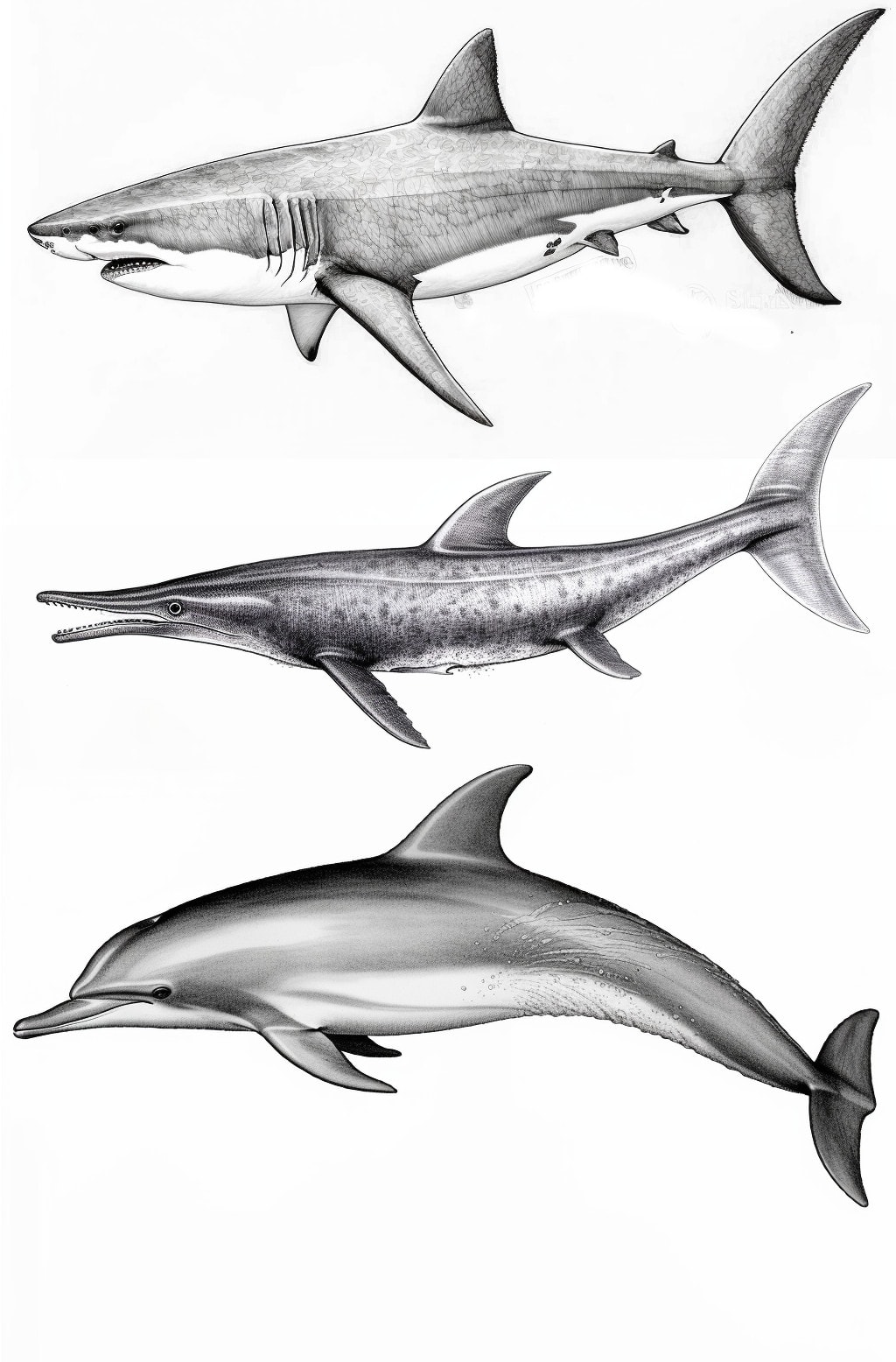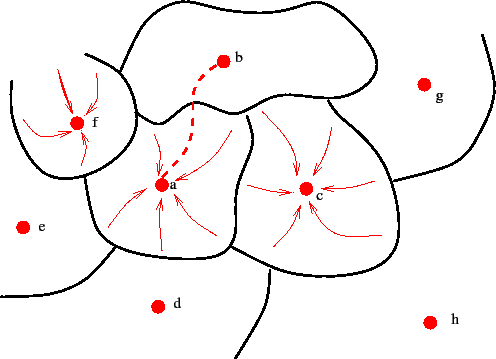Prelude: sharks, aliens, and AI
If you go back far enough, the ancestors of sharks and dolphins look really different:


But modern day sharks and dolphins have very similar body shapes:

This is a case of convergent evolution: the process by which organisms with different origins develop similar features. Both sharks and dolphins needed speed and energy efficiency when moving in an environment governed by the laws of hydrodynamics, and so they converged on a pretty similar body shape.
For us, this isn’t very surprising, and doesn’t require much knowledge of evolution: we have a good intuitive understanding of how water works, and humans knew a lot of the underlying maths for the laws of hydrodynamics before they understood anything about evolution. Starting from these laws, it isn’t very surprising that sharks and dolphins ended up looking similar.
But what if instead of starting with knowledge of hydrodynamics and then using that to explain the body shape of sharks and dolphins, we started with only knowledge of sharks’ and dolphins’ body shape, and tried to use that to explain underlying laws?
Let’s pretend we’re alien scientists from an alternative universe, and for some weird reason we only have access to simplified 3D digital models of animals and some evolutionary history, but nothing about the laws of physics in the human/shark/dolphin universe. My guess is that these alien scientists would probably be able to uncover a decent amount of physics and a fair bit about the earth’s environment, just by looking at cases of convergent evolution.
If I’m right about this guess, then this could be pretty good news for alignment research. When it comes to thinking about AI, we’re much closer to the epistemic position of the alien scientist: we either don't know the ‘physics’ of life and intelligence at all, or are only just in the process of uncovering it.
But cases of convergent evolution might help us to deduce deep selection pressures which apply to AI systems as well as biological ones. And if they do, we might be able to say more about what future AI systems might look like, or, if we are lucky, even use some of the selection pressures to shape what systems we get.
Introduction
This post argues that we should use cases of convergent evolution to look for deep selection pressures which extend to advanced AI systems.
Convergent evolution is a potentially big deal for AI alignment work:
- Finding deep selection pressures could help us predict what advanced AI systems will be like.
- It seems plausible that some of the properties people in the alignment space assume are convergent don’t actually extend to advanced AI.
In this post, I’ll:
- Share some basics of convergent evolution,
- Argue that this is a big deal for alignment work, and then
- Respond to the objection that biology is super different from AI.
The basics of convergent evolution
The body shape of sharks and dolphins is just one of very many examples of convergent evolution in biology. For example:
- Visual organs arose “possibly hundreds of times”.
- Multicellularity evolved independently probably at least 11 times.
- Some form of higher-level intelligence evolved multiple times - in primates, apes, corvids, cetaceans, elephants - and possibly many other cases, depending on thresholds and definitions.
We can think about convergent evolution in terms of:[3]
- a basin of convergent evolution,
- an attractor state(s), and
- selection pressure(s).
The basin of convergent evolution is the region of the abstract space in which, once an organism enters the basin, the pull of the selection pressure brings the organism closer to the attractor state.[4]

In the case of sharks and dolphins:
- The basin of convergent evolution is hunting fish in water in a certain way.
- The attractor state is the rough body shape which sharks and dolphins share.
- The selection pressures are the laws of hydrodynamics, and the need for speed and energy efficiency when moving in an environment governed by those laws.
There are some important nuances here.
Firstly, if you back out far enough, cases of convergent evolution are always contingent on something.
Contingent evolution is the process by which organisms develop different traits under the same conditions, because of contingent factors (like random mutations or interspecies encounters). At first, convergent and contingent evolution sound like opposites, but actually they are fractal: every instance of convergent evolution is contingent on some higher level thing. To take our shark and dolphin example, their body shape is contingent on them both being vertebrates. Invertebrates under the same conditions don’t develop that sort of body shape.
Another way of putting this point would be that organisms have to enter the basin for the selection pressures to apply. Different factors determine entry, including both features of the environment and features of the organism. Entry into the basin of convergent evolution which dolphins and sharks both fell into seems to require vertebrae, among other things.
Secondly, similarity/generality do not necessarily imply convergence. Many animals have hooves, but they all share a common ancestor. This is a case of homology, not convergent evolution. The fact that hooved animals are quite widespread shows us that hooves are not maladaptive - but we don’t get the kind of strong signal we would from convergent evolution that hooves are uniquely adaptive. To say that X is convergent, you need to be able to point to multiple different origins converging to points close to X. It’s not enough to just observe that there’s a lot of X around.
Both of these nuances limit and clarify the concept of convergent evolution. Convergent evolution is limited in that there are many common phenomena which it can’t explain (like hooves). But it’s also unusually predictive: provided you understand the scope of the basin of convergent evolution (or in other words, can back out accurately what the convergent evolution is contingent on), then within that basin there’s not much room for things to go otherwise than fall towards the attractor state.
That’s a substantive proviso though: it can be very tricky to back out the contingencies, so often there will be uncertainty about exactly where the selection pressures apply.
This is a potentially big deal for AI alignment work
Convergent evolution might point to deep selection pressures
Firstly, cases of convergent evolution might point to deep selection pressures which help us predict what advanced AI will be like.
There is some work of this type already in the alignment space, but we think it’s a promising area for further exploration.
There are at least a few different ways of exploring this idea, and probably others we haven’t thought of yet:
- You can look for attractor states which seem convergent across many domains. This post has mostly focused on biological evolution, but convergent evolution can also be expanded beyond biology, to things like culture, technology and software. The further out you have to go to find the contingency, the more general the case of convergent evolution is, and the more likely it is that advanced AI systems will fall into the basin of convergence too. Searching for properties which are convergent across many kinds of systems (biological, cultural, economic, technological…) might point us towards convergences which hold for advanced AI systems.
- You can start with a guess about a selection pressure, and then try to figure out what basin of convergence it should apply to. Then you can check whether in reality it does apply or not.
- If it does, that’s some evidence that you’re onto something.
- If it doesn’t, that’s some evidence that you’re missing something.
Here are some examples where I think that convergent biological evolution points to some deep selection pressures, which are likely to also be relevant for understanding advanced AI systems. We will go into more detail and unpack implications in followup posts.
Multicellularity
- In biological organisms, multicellularity evolved independently probably at least 11 times. Intuitively, multicellular organisms unlocked new levels of complexity and power in living things.
- There’s a possible analogy between multicellularity and division of labour in human economies, leading to "civilization" and transition to a period of faster growth of human power , which contributed to the rise of "civilization" and the transition to a period of faster growth in human power.
- A candidate for the selection pressure here is ‘specialise and trade’:
- In economics this is represented by Ricardo’s law (comparative advantage), which explains economic specialisation.
- You can make a similar argument for multicellularity. An advantage for a simple multicellular organism might be, for example, that some of the cells specialise at movement, and some at food processing. Part of the cells, for example, develop flagella.
- Candidates for the boundaries of the basin of convergence include how easy it is to scale the capacity of an individual, and how easy it is to solve coordination problems between individuals.
- For example, if it were easy for cultural evolution to scale the capacity of individual humans arbitrarily, there would be less pull towards specialisation. If coordination between individual humans were extremely difficult, there would also be less pull towards specialisation.
- Goal-directed systems tend to be made out of parts which are themselves also goal-directed.[6] It is likely that something like this might also be the case for advanced AI systems.
- It’s possible that collectives or "swarms" of somewhat intelligent AI systems (such as LLMs) might form larger emergent systems in response to selection pressures similar to those which caused multicellularity.[7]
Agency
- Agency (in the sense of Dennett’s intentional stance[8]) seems somewhat convergent: it arises in many different animals.
- But most animals don’t seem strongly agentic. To understand animal behaviour, you usually need not just the ‘goal’ of the animal but also quite a lot of information about the ways in which the animal is bounded, its instincts and habits, etc.
- In other words, the attractor state doesn’t seem very pointy.
- Understanding why seems like it might help us think about agency in advanced AI systems.
- A preliminary guess: information processing is costly; some forms of coherence and agency require more information processing all else equal; and it’s often not worth the additional costs.
"Intelligence"
- Some form of higher-level intelligence evolved multiple times - in primates, apes, corvids, cetaceans, elephants - and possibly many other cases, depending on thresholds and definitions.
- Understanding of the selection pressures here is an active area of research in biology, and it's not clear what the best explanation is.[9]
- One hypothesis is that runaway selection for social skills leads to intelligence.[10]
- (Primates, apes, corvids, cetaceans, elephants and humans are all social.)
- This intuitively makes sense: in most natural environments, there may be sharply diminishing returns from spending more energy on energy-hungry brains modelling a fixed complexity environment better. However, if the really important part of the environment are other similarly complex minds, this can lead to a race in intelligence.
- If selection pressure towards modelling other minds leads to intelligence, this would have important implications for AI development and AI risk.
"Sentience"
Epistemic status: this subsection is highly speculative, more than the others.
- This is possibly the most controversial example, and biological literature often shies away from the topic, with some recent exceptions.[11] On the other hand, the topic is of central importance to moral philosophy.
- There is some literature exploring how functional theories of consciousness such as global workspace theory could be related to properties of machine learning architectures.[12]
- Understanding the possible convergence of whatever the morally relevant properties of systems are could be important for avoiding mind crimes.
There are multiple other possibly relevant examples we decided not to include in this post, but we recommend thinking about it for yourself and posting further examples as comments.
The limits of convergent evolution may challenge some existing ideas in AI alignments
Secondly, in my view, lots of existing alignment research implicitly or explicitly relies on convergence.
- Often there has been an implicit or explicit assumption in alignment research that something like VNM rationality or goal coherence is convergent for sufficiently intelligent systems.
- Many arguments about AI risk stem from the idea of instrumental convergence - that specific goals such as self-preservation and power-seeking are likely to be convergent goals for any rational agent.
- The natural abstraction hypothesis is a hypothesis that there are some selection pressures and some basin of attraction such that certain concepts are natural abstractions/an attractor state.
- Selection theorems is an abstracted and simplified way of looking at convergent evolution, applied to agency specifically.
It seems plausible that for some of the properties people in the alignment space assume are convergent, the relevant basin actually doesn’t extend to advanced AI, or the specific selection pressures are just one of many, making the attractor states not too deep.
Thinking through convergent evolution makes the reasons why these cases of convergence may be relevant clearer. At the same time, the interplay between convergence and contingency, and the limited extent to which some of these pressures seem to shape living things, may point to some of the basins of convergence not being as universal as assumed, or the selection pressures not being that strong. It would be good to have a more explicit discussion of what these cases of convergence are contingent upon, and how clear it is that advanced AI systems will meet those conditions.
But biology is super different from AI, no?
Yes, biology is super different from AI.
Evolution is not ‘smart’ - but over the past few billion years, it has had a lot of compute and has explored a lot. [13]
And evolution didn’t just explore spaces like ‘body shapes made of flesh’, which aren’t very relevant to AI systems. It also explored spaces like ‘control theory algorithms implementable by biological circuits’ and ‘information processing architectures’. Looking at the properties which were converged upon in spaces like that can hopefully tell us something about the underlying selection pressures.
While details of what biological evolution found are contingent, it seems likely that vast convergences across very different species, or even across very different systems like culture and technology, point to deeper selection pressures which apply to AI systems too.

The ideas in this post are mostly Jan’s. Special thanks to Clem who made substantial contributions especially on the parts about contingency, and plans to write a follow up post on the relevance of contingency to AI alignment research. Thanks also to TJ, Petr Tureček and John Wentworth for comments on a draft. Rose did most of the writing.
- ^
Nobu Tamura (http://spinops.blogspot.com), CC BY 3.0, via Wikimedia Commons.
- ^
Nobu Tamura (http://spinops.blogspot.com), CC BY 3.0, via Wikimedia Commons.
- ^
This way of thinking about convergent evolution is used by evolutionary biologists, e.g. here. There are also other ways of approaching it, most commonly in terms of fitness landscape, where instead of individuals falling down into attractor states, selection pressures push individuals uphill. Conventions depend on the subfield.
- ^
Note that the attractor state applies to some feature or features of the organism, but is irrelevant to most others. In the shark and dolphin case, the attractor relates to body shape, but does not affect other features like type of immune cells.
- ^
https://commons.wikimedia.org/wiki/File:Local_search_attraction_basins.png , CC BY-SA 3.0 <http://creativecommons.org/licenses/by-sa/3.0/>, via Wikimedia Commons.
- ^
See https://www.frontiersin.org/articles/10.3389/fpsyg.2019.02688/full and this on hierarchical agency.
- ^
- ^
Roughly:
- You can look at any system as an agent
- A system is more agentic the more that describing it using the intentional stance is useful, relative to other stances.
- ^
Some candidates: parasitoidism; a combination of causal reasoning, flexibility, imagination, and prospection.
- ^
This paper argues that different pressures operated in different taxa, and that for some taxa social learning was a key selection pressure.
- ^
For example, The Evolution of the Sensitive Soul: Learning and the Origins of Consciousness by Simona Ginsburg, Eva Jablonka.
- ^
- ^
Stochastic gradient descent also isn’t the smartest designer, but with enough compute it’s been able to find the smartest AI systems we have.